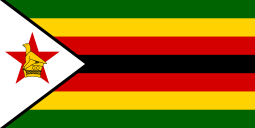Culture of Zimbabwe
Zimbabwe has many different cultures, which may include beliefs and ceremonies, one of them being Shona. Zimbabwe's largest ethnic group is Shona. The Shona people have created many sculptures and carvings which are made with the finest materials available.
| Part of a series on the |
| Culture of Zimbabwe |
|---|
 |
| History |
| People |
| Languages |
| Cuisine |
| Religion |
| Art |
|
Music and performing arts |
| Sport |
|
Monuments
|
|
Symbols |
|
|
Art
Traditional arts in Zimbabwe include pottery, basketry, textiles, jewelry and carving. Among the distinctive qualities are symmetrically patterned woven baskets and stools carved out of a single piece of wood. Shona sculpture in essence has been a fusion of African folklore with European influences. Also, a recurring theme in Zimbabwean art is the metamorphosis of man into beast.
Among members of the white minority community, theatre has a large following, with numerous theatrical companies performing in Zimbabwe's urban areas.
Though the country's art is admired by those that know of its existence, several Zimbabwean artists have managed to gain a world audience, to name some world-famous Zimbabwean sculptors, we have Nicholas, Nesbert and Anderson Mukomberanwa, Tapfuma Gutsa, Henry Munyaradzi, and Locardia Ndandarika. Internationally, Zimbabwean sculptors have managed to influence a new generation of artists, particularly African Americans, through lengthy apprenticeships with master sculptors in Zimbabwe. Contemporary artists, including New York sculptor M. Scott Johnson and California sculptor Russel Albans have learned to fuse both African and Afro-diasporic aesthetics in a way that travels beyond the simplistic mimicry of African Art by some Black artists of past generations in the United States.
Language
Zimbabwe has 16 official languages,[1] Chewa, Chibarwe, English, Kalanga, "Koisan" (presumably Tsoa), Nambya, Ndau, Ndebele, Shangani, Shona, "sign language" (Zimbabwean sign languages), Sotho, Tonga, Tswana, Venda, and Xhosa. Much of the population speaks Bantu languages, such as Shona (chishona) (76%) and Ndebele (18%). Shona has a rich oral tradition, which was incorporated into the first Shona novel, Feso by Solomon Mutswairo, published in 1957. English is spoken primarily in the cities, but less so in rural areas. Education in Zimbabwe is taught in English, Shona and Ndebele. Many rural primary schools teach in the native language until grade three; then, school is taught in English.[2]
Food
Like in many African countries, a majority of Zimbabweans depend on staple foods. "Mealie meal", or cornmeal as it is known in other parts of the world, is used to prepare bota, a porridge made by mixing cornmeal with water, to make a thick paste. This is usually flavored with butter or peanut butter. Bota is usually eaten for breakfast. Cornmeal is also used to make sadza, which is usually eaten for dinner, and by many for lunch too. The process of making sadza is similar to bota, however after the paste has been cooking for several minutes, more cornmeal is added to thicken the paste until it is firm. This meal is usually served with vegetables (spinach, chou moellier, or spring greens/collard greens), beans, and meat (stewed, grilled, roasted, or sundried). Sadza is also commonly eaten with boerewors (a sausage made from beef or pork), chicken, or curdled milk (sour milk), commonly known as "lacto" (mukaka wakakora or "amasi"). Rice and chicken with coleslaw salad is often served as the main meal. Graduations, weddings, and any other family gatherings will usually be celebrated with the killing of a goat, sheep, or cow, which will be braaied (or barbecued) for the gathered family.
Since Zimbabwe was a British colony, they have adopted some English habits. For example, most people will have porridge in the morning, however they will still have 10 o'clock tea (midday tea). They will have lunch, which can be leftovers from the night before, freshly cooked sadza, or sandwiches (which is more common in the cities). After lunch, there is usually 4 o'clock tea (afternoon tea), which is served before dinner. It is not uncommon for tea to be had after dinner.
See also
- Architecture of Zimbabwe
- Balancing Rocks
- Education in Zimbabwe
- Reps Theatre and Over the Edge (Zimbabwe Theatrical Companies)
- Music of Zimbabwe
- Rhodesiana
- Zimbabwean legends
References
- Nemukuyu, Daniel. "Constitution now available in 16 languages". The Herald. Retrieved 26 December 2018.
- "Zimbabwe Education System". www.classbase.com. Retrieved 2015-10-19.